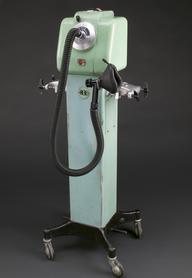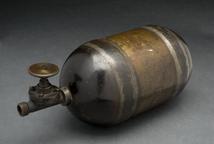





Face mask for Snow-type chloroform anaesthesia, English, c1870
The design of the face mask has been attributed to Francis Sibson (1814-76) and early examples were made of sheet lead. This example is made from brass and lined with felt. It would have been used by patients to inhale vapours of chloroform to enter a state of unconsciousness before surgery.
John Snow (1813-1858) developed a chloroform inhaler that attached to this mask. Two canisters, one with cold water and another with chloroform to ensure a 4% mix of the anaesthetic vapour in air. Snow adminsitered anaesthetics to Queen Victoria during her births. He is also known for linking the use of a water pump in London with the spread of cholera.
Details
- Category:
- Anaesthesiology
- Collection:
- Sir Henry Wellcome's Museum Collection
- Object Number:
- A625286
- Materials:
- face mask, brass and face mask, velvet
- Measurements:
-
overall: 87 mm x 55 mm x 110 mm, .12kg
- type:
- anaesthetic mask




